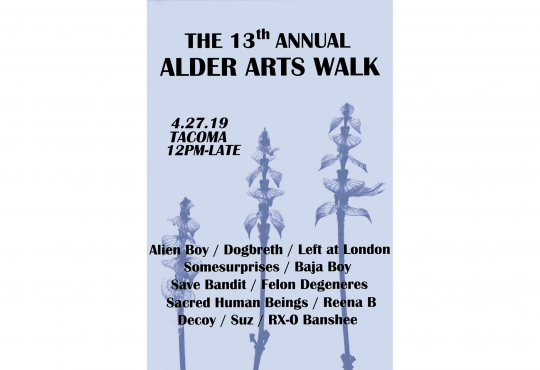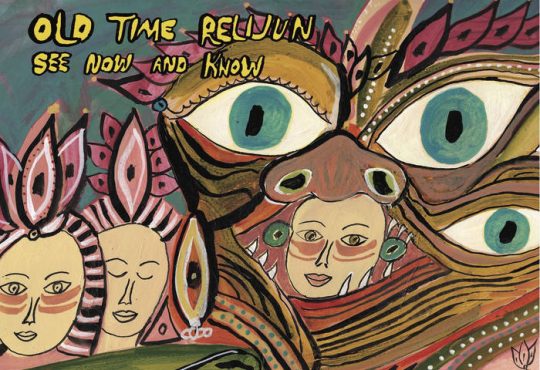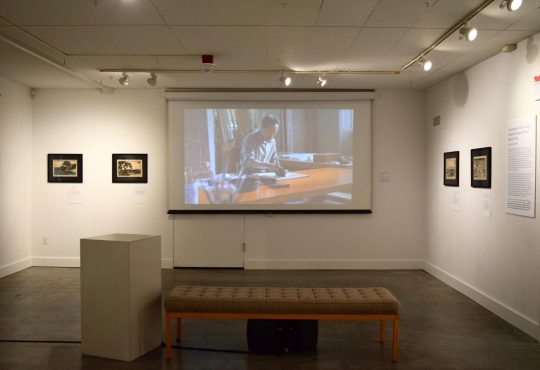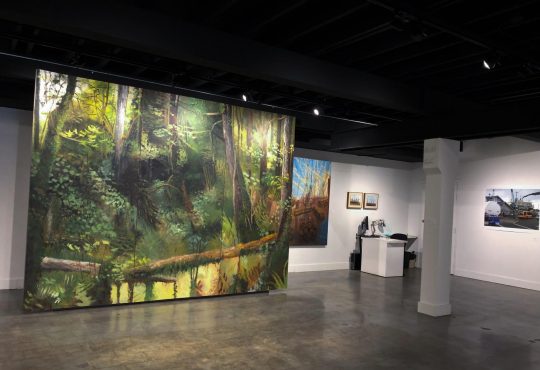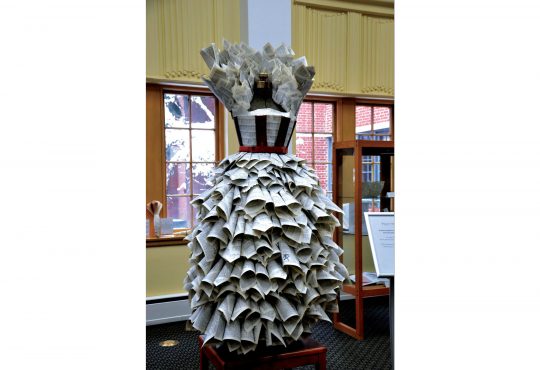
Jaune Quick-to-See Smith’s intense and powerful paintings unearth the often forgotten history and consciousness of the Native American people. Smith draws on her Salish-Kootenai roots to tell stories of pain, resilience, conflict and peace.
Smith’s work will be on display through June 30 in her first solo exhibition in Tacoma courtesy of the Tacoma Art Museum (TAM) and the Yellowstone Art Museum. The exhibit, “Footsteps of My Ancestors,” features an extensive body of mature works dating back to the 1970s.
TAM hosted an exhibition preview on March 8, where TAM members and people from the community got a first look at the new exhibition. The event started with drinks and music and ended with a speech by TAM Executive Director David Setford and Haub Curator of Western American Art Faith Brower, as well as a walk through the gallery with the artist herself.
“Her work creates a really incredible legacy that helps us all more deeply consider social, political, and environmental issues,” TAM Executive Director David Setford said.
The exhibition of mostly large mixed media oil paintings and smaller lithographic prints is dramatic and eye-catching. With stark textures, brush strokes, drips and bold colors, Smith’s work is aesthetically captivating.
“A friend of mine who is a video artist, every time I meet him he tells me, ‘Painting is dead!’ Well, if painting is dead I want you to tell me what’s going on in that room up there because it is the most lively, the most amazing group of works, the most brilliant group of work I have seen for a long time,” Setford said.
Smith’s work is not only meant to please the eye. Beneath the layers of carefully constructed mixed-media collage and washes of bright pigment lies incredibly meaningful symbolism meant to provoke thought and spur action.
One painting, “Untitled (Memory Map),” shows a map of the United States overlaid with stark black Native American symbols. The painting is meant to express Native Americans’ connection to the land and to remind the viewer of their painful history. As a Native American woman who grew up on a reservation, Smith is closely connected to this past.
“We moved to Nisqually, I lived in a one-room cabin with two other families, slept on the floor on a blanket rolled up against the wall because we didn’t have any furniture. It was right after the second world war and, for Native Americans, it was a really tough time. My sister and I were sick all of the time, there wasn’t enough food to go around. I remember going behind the cabin and searching for food in garbage piles … those are my early memories here in Washington State, you know where life is pretty good … for Native Americans it wasn’t. It was quite different,” Smith said.
Many of Smith’s works do not only detail the struggles that Native people face, but also celebrate their resilience and sense of community. A series of lithographic prints, “The Survival Series,” titled “Humor,” “Medicine,” Knowledge” and “Community,” are full of bold Native American symbolism and celebrate different aspects of Native American culture.
It is important for Smith to express the feelings of her people and at the same time, use her paintings as a method to teach the public about Native American issues and history. Many of her paintings have a darker, political tone that draws attention to global issues.
“I was doing work about the environment and doing paintings about the environment and here we are today, you know climate change is just becoming a big issue but I was on that message and continually on that message with my work. So a lot of the work here has threaded its way through issues about the environment or war,” Smith said.
Another piece called “The Swamp” depicts a figure that is both human and animal standing in a swamp surrounded by symbols. The piece is meant to show the importance of the environment, animals and our connection or lack of connection to them.
“This work is really important to me. It’s not just about the paintings, although, I’m a painter and I love to paint and I love moving paint around, but it is about getting the messages out that were not there when I was a little girl here. I’ll be 80 years old this coming year and so this is a really important process for me,” Smith said.
Smith’s beautiful and timeless work goes beyond painting and teaches us about our world and the creatures in it. “In the Footsteps of My Ancestors” shares a powerful lesson in the interconnectedness and resilience of the Native people and wills us all to follow a similar path.
Jaune Quick-to-See Smith’s intense and powerful paintings unearth the often forgotten history and consciousness of the Native American people. Smith draws on her Salish-Kootenai roots to tell stories of pain, resilience, conflict and peace.
Smith’s work will be on display through June 30 in her first solo exhibition in Tacoma courtesy of the Tacoma Art Museum (TAM) and the Yellowstone Art Museum. The exhibit, “Footsteps of My Ancestors,” features an extensive body of mature works dating back to the 1970s.
TAM hosted an exhibition preview on March 8, where TAM members and people from the community got a first look at the new exhibition. The event started with drinks and music and ended with a speech by TAM Executive Director David Setford and Haub Curator of Western American Art Faith Brower, as well as a walk through the gallery with the artist herself.
“Her work creates a really incredible legacy that helps us all more deeply consider social, political, and environmental issues,” TAM Executive Director David Setford said.
The exhibition of mostly large mixed media oil paintings and smaller lithographic prints is dramatic and eye-catching. With stark textures, brush strokes, drips and bold colors, Smith’s work is aesthetically captivating.
“A friend of mine who is a video artist, every time I meet him he tells me, ‘Painting is dead!’ Well, if painting is dead I want you to tell me what’s going on in that room up there because it is the most lively, the most amazing group of works, the most brilliant group of work I have seen for a long time,” Setford said.
Smith’s work is not only meant to please the eye. Beneath the layers of carefully constructed mixed-media collage and washes of bright pigment lies incredibly meaningful symbolism meant to provoke thought and spur action.
One painting, “Untitled (Memory Map),” shows a map of the United States overlaid with stark black Native American symbols. The painting is meant to express Native Americans’ connection to the land and to remind the viewer of their painful history. As a Native American woman who grew up on a reservation, Smith is closely connected to this past.
“We moved to Nisqually, I lived in a one-room cabin with two other families, slept on the floor on a blanket rolled up against the wall because we didn’t have any furniture. It was right after the second world war and, for Native Americans, it was a really tough time. My sister and I were sick all of the time, there wasn’t enough food to go around. I remember going behind the cabin and searching for food in garbage piles … those are my early memories here in Washington State, you know where life is pretty good … for Native Americans it wasn’t. It was quite different,” Smith said.
Many of Smith’s works do not only detail the struggles that Native people face, but also celebrate their resilience and sense of community. A series of lithographic prints, “The Survival Series,” titled “Humor,” “Medicine,” Knowledge” and “Community,” are full of bold Native American symbolism and celebrate different aspects of Native American culture.
It is important for Smith to express the feelings of her people and at the same time, use her paintings as a method to teach the public about Native American issues and history. Many of her paintings have a darker, political tone that draws attention to global issues.
“I was doing work about the environment and doing paintings about the environment and here we are today, you know climate change is just becoming a big issue but I was on that message and continually on that message with my work. So a lot of the work here has threaded its way through issues about the environment or war,” Smith said.
Another piece called “The Swamp” depicts a figure that is both human and animal standing in a swamp surrounded by symbols. The piece is meant to show the importance of the environment, animals and our connection or lack of connection to them.
“This work is really important to me. It’s not just about the paintings, although, I’m a painter and I love to paint and I love moving paint around, but it is about getting the messages out that were not there when I was a little girl here. I’ll be 80 years old this coming year and so this is a really important process for me,” Smith said.
Smith’s beautiful and timeless work goes beyond painting and teaches us about our world and the creatures in it. “In the Footsteps of My Ancestors” shares a powerful lesson in the interconnectedness and resilience of the Native people and wills us all to follow a similar path.

